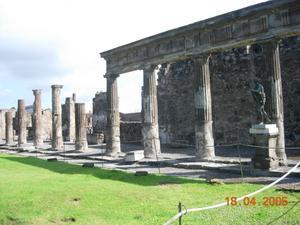Advertisement

 Temple Ruins
Temple Ruins
We saw a staggering amount of carved marble used in the homes and public buildings. The pillars, facades and exquisite detail of the buildings were fascinating. We docked at Naples, which is about halfway between the ankle and the knee on Italy's boot. Cruising into the Bay of Naples we were greeted by the sight of a beautiful harbor city with the mighty Vesuvius dominating the view to the south.
We were in Naples for only one day. We chose to spend our time ashore seeing the ruins of Pompeii, the town between Naples and Vesuvius that was buried under ashes and volcanic dust in the eruption of 79 AD. Excavation started in the 1700s when Pompeii was discovered and is still going on at several sites including nearby Herculaneum.
The eruption of Vesuvius was described in great detail by Pliny the Younger, who at the time was a well educated Roman teenager visiting his uncle, Pliny the Elder, a government official near Naples. Uncle Pliny made the mistake of trying to go to the disaster area to help survivors, and was himself overcome by the volcanic residue and perished. Young Pliny had been left behind with his mother and survived. He later wrote a fascinating account of the entire experience. If you like, see Pliny's description at
http://www.eyewitnesstohistory.com/pompeii.htm
Advertisement
Tot: 0.382s; Tpl: 0.173s; cc: 13; qc: 32; dbt: 0.1722s; 1; m:domysql w:travelblog (10.17.0.13); sld: 9;
; mem: 1.1mb

 Temple Ruins
Temple Ruins























Joanna
non-member comment
beautiful photos
thankyou for the beautiful images. I use them on my desktop and look at them and sigh